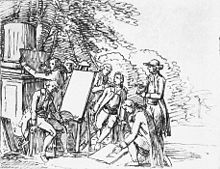You can help expand this article with text translated from the corresponding article in German. (February 2016) Click for important translation instructions.
|
| Friedrich Bury | |
|---|---|
 Portrait of Bury by unknown, Portrait of Bury by unknown,c. 1784 | |
| Born | Johann Friedrich Bury (1763-03-13)13 March 1763 Hanau, Hesse, Germany |
| Died | 18 May 1823(1823-05-18) (aged 60) Aachen, North Rhine-Westphalia, Germany |
| Nationality | German |
| Known for | |


Friedrich (Fritz) Bury (12 March 1763 – 18 May 1823) was Court painter to the royal courts of Kassel and Brussels, a German painter born in Hanau. He studied first under his father Jean Jacques Bury, who was a goldsmith and professor in the Academy of Design in Hanau, and with Anton Wilhelm Tischbein. In 1780 he visited for two years the Kunstakademie Düsseldorf, where he met Johann Heinrich Lips (who was 5 years older), with whom he returned to Hanau at the age of 19 and two month later they traveled to Rome. From November 1782 to July 1785 he lived with a nephew of Tischbein, Johann Heinrich Wilhelm Tischbein, Johann Georg Schütz and Lips in a rear building of the Palazzo Piombino in Via del Babuino 51. Later they followed their landlord to Via del Corso no. 18, now known as the Casa di Goethe, as Johann Wolfgang von Goethe also lived and worked there for over a year.

After Goethe's departure, Bury lived in the former Tischbein studio on the second floor. Bury's role model was, easily recognizable, the Raphael teacher Perugino, but also Fra Bartolommeo and Andrea Mantegna.
It was through Goethe that he met his second mentor in Rome, Duchess Anna Amalia of Saxe-Weimar. On behalf of his two Weimar mentors, Bury made copies of masterpieces, not from the 15th century as they had wished, but from the 14th century. Bury accompanied Anna Amalia to Venice, where Goethe was already waiting. This was followed by a joint journey to Padua, Vicenza, Verona and, at the end of May 1790, Mantua. From there, Goethe and Anna Amalia returned to Weimar, Bury remained. Due to the occupation of Rome by French troops, he was forced to return to Hanau. He initially tried to establish himself in Weimar. When this failed, he went to Kassel and Dresden and finally settled in Berlin, where he was presented to the Prussian royal family. He became a portraitist and teacher of two daughters, Princess Augusta of Prussia and Wilhelmine of Prussia, Queen of the Netherlands.
Selected portraits
-
 Portrait of Auguste von Hessen-Kassel, ca. 1815, now at the Museum Schloss Elisabethenburg Meiningen
Portrait of Auguste von Hessen-Kassel, ca. 1815, now at the Museum Schloss Elisabethenburg Meiningen
-
 Portrait of Johann Wolfgang von Goethe, chalk drawing from 1800.
Portrait of Johann Wolfgang von Goethe, chalk drawing from 1800.
Other works
-
 Portrait of Janus Genelli (1761–1813), 1800-1805.
Portrait of Janus Genelli (1761–1813), 1800-1805.
-
 Portrait of Countess Luise von Voss, 1810.
Portrait of Countess Luise von Voss, 1810.
-
 Portrait of Count Karl Hermann von Wylich-Lottum, 1809.
Portrait of Count Karl Hermann von Wylich-Lottum, 1809.
-
 Portrait of General Gerhard Johann David von Scharnhorst, c. 1810
Portrait of General Gerhard Johann David von Scharnhorst, c. 1810
-
 Portrait of Captain Wilhelm Friedrich Ernst von Dalwigk zu Schauenburg, 1805-1810.
Portrait of Captain Wilhelm Friedrich Ernst von Dalwigk zu Schauenburg, 1805-1810.
-
 Double portrait of sisters Sophie and Emma Charlotte Constanze von Wylich und Lottum [de], early 19th century.
Double portrait of sisters Sophie and Emma Charlotte Constanze von Wylich und Lottum [de], early 19th century.
-
 Madonna and Child with Donors, early 19th century.
Madonna and Child with Donors, early 19th century.
See also
References
- "chronicle family Bury". Archived from the original on 1 July 2017. Retrieved 11 February 2015.
- (de) Der Maler Friedrich Bury (1763–1823): Goethes 'zweiter Fritz', Deutscher Kunstverlag; 2013, ISBN 978-3422072084, p. 60
- (de) Der Maler Friedrich Bury (1763–1823): Goethes 'zweiter Fritz', p. 63
- (de) See Briefe 26 bis 30 in Friedrich Bury: Briefe aus Italien an Goethe und Anna Amalia, Wallstein Verlag, Göttingen 2007, ISBN 978-3835301412
- (de) Friedrich Bury: Briefe aus Italien a Goethe und Anna Amalia p. 216
Attribution:
 This article incorporates text from a publication now in the public domain: Bryan, Michael (1886). "Büri, Friedrich". In Graves, Robert Edmund (ed.). Bryan's Dictionary of Painters and Engravers (A–K). Vol. I (3rd ed.). London: George Bell & Sons.
This article incorporates text from a publication now in the public domain: Bryan, Michael (1886). "Büri, Friedrich". In Graves, Robert Edmund (ed.). Bryan's Dictionary of Painters and Engravers (A–K). Vol. I (3rd ed.). London: George Bell & Sons.